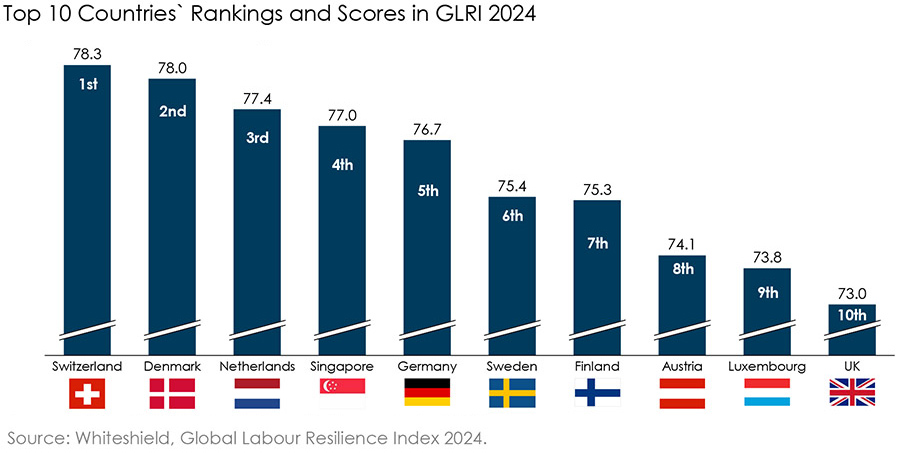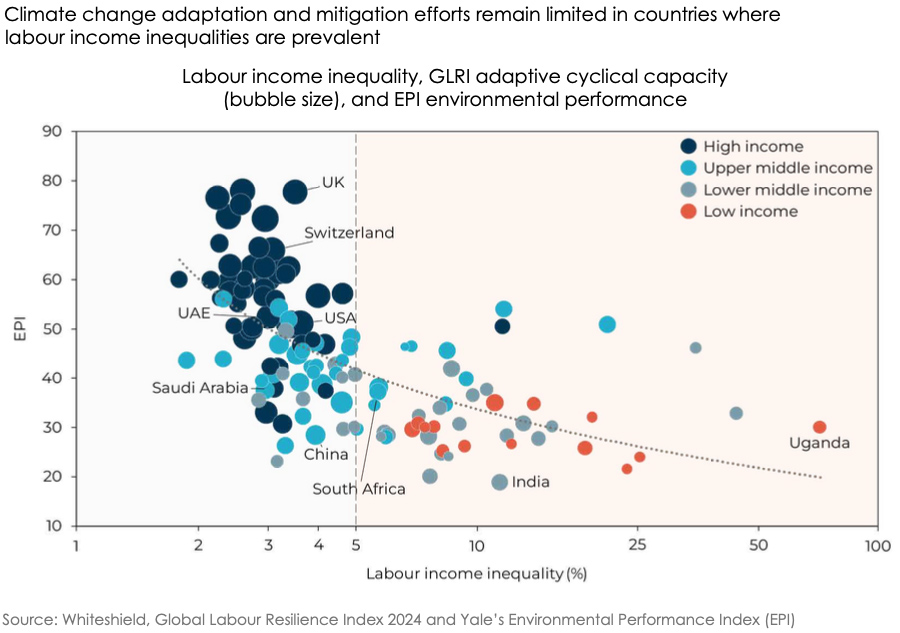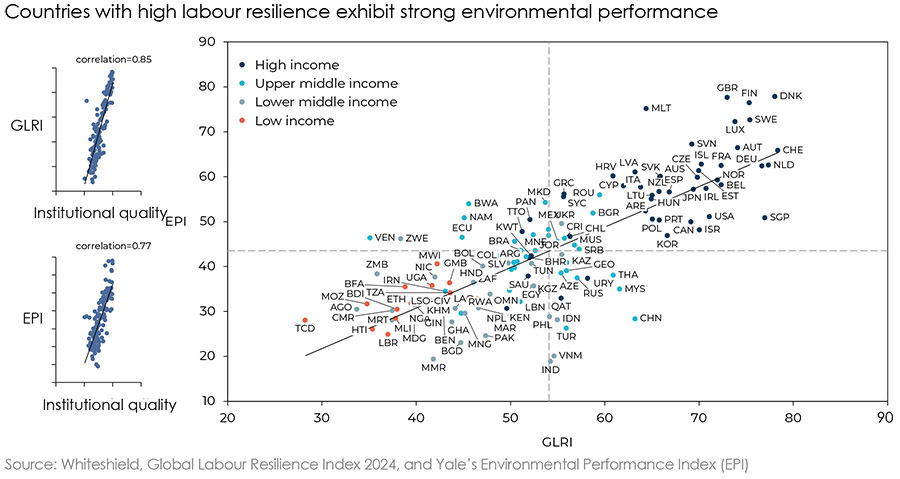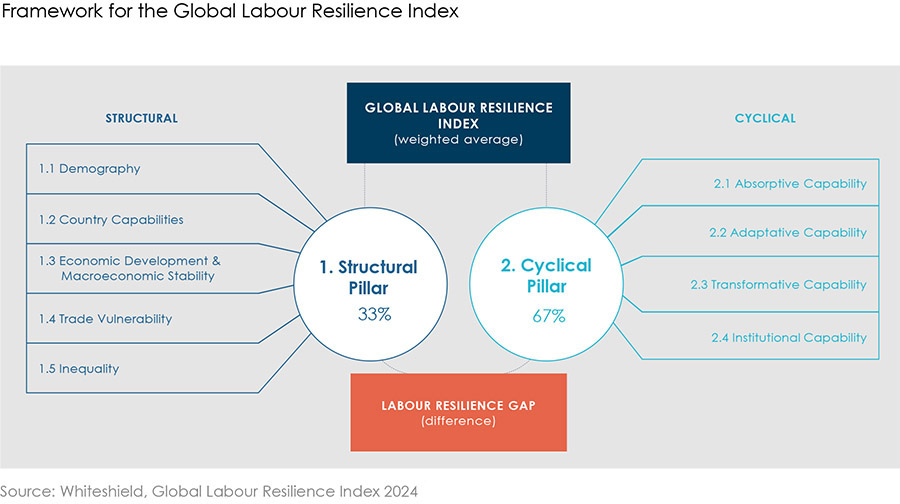More resilient labour markets enable better climate response
More resilient labour markets enable better climate response Consultancy.uk


Countries with Resilient Labour Markets are also Climate-Friendly
Countries with more resilient labour markets are also some of the world’s most climate-friendly, according to research from London-headquartered strategy advisory firm Whiteshield.
In its annual Global Labour Resilience Index, Whiteshield has demonstrated that countries with the most resilient labour markets tend to also be the greenest. European countries, in particular, are at the very top of the list – and for good reason.
Top Countries in the Global Labour Resilience Index
- Switzerland
- Denmark
- Netherlands

According to the Whiteshield research, climate action and policy are a catalyst to ‘greening’ the labour market. That means that ambitious action on sustainability and labour market policies tailored to the coming transition go hand-in-hand.
These active labour market policies have proven to be more effective in environments characterised by macroeconomic stability, an open and transparent trade and investment regime, and an enabling business environment operating in countries with high quality institutions.

The green transition does not need to be a new source of inequality, which is already rampant in countries around the world. Countries that have yet to build strong adaptive capabilities in their labour market, such as India and South Africa, also lag behind in their environmental performance.
This is most apparent in lower-income countries that are disproportionately affected by the negative impacts of climate change. This is also where populations often work in industries that are more susceptible to climate events.
Climate policies aimed at achieving net-zero carbon emissions can amplify inequalities in countries that lack a resilient labour market. For example, countries that have large fossil fuel, industrial, or automotive sectors are obviously susceptible to labour instability when these carbon-heavy industries are inevitably phased out.

“The Global Labour Resilience Index underscores the need for targeted policies and effective institutions to catalyse the ‘greening’ of the labour market amid structural changes in the global economy,” said Raed Safadi, chief economist at Whiteshield.
About the Global Labour Resilience Index
The Global Labour Resilience Index (GLRI) is based on a wide array of metrics and takes into account issues that affect countries around the world, like climate change, migration, and policy changes. The index aims to provide insight that can help countries strengthen their labour markets, with the imperative of transitioning to sustainable economies promising a bumpy ride ahead for the unprepared.
The index splits its attention to structural and cyclical resilience, with a score for each country in both categories:

Structural resilience means attention and action towards longer-term issues like demographics, macroeconomic stability, trade, and inequality. Cyclical resilience, on the other hand, is built by being well prepared for short-term shocks, being equipped for quick recover, and keeping up with major trends.
A resilient labour market is defined by the researchers as one that generates sustainable demand for a wide range of occupations and supplies quality work. Resilient labour markets are inclusive, sustainable, and able to withstand shocks because of their flexibility and adaptability.
Late last year, Whiteshield released its Global Trade Resilience Index, the firm’s other annual flagship report.
SDGs, Targets, and Indicators
-
SDG 7: Affordable and Clean Energy
- Target 7.2: By 2030, increase substantially the share of renewable energy in the global energy mix.
-
SDG 8: Decent Work and Economic Growth
- Target 8.5: By 2030, achieve full and productive employment and decent work for all women and men, including for young people and persons with disabilities, and equal pay for work of equal value.
- Target 8.8: Protect labor rights and promote safe and secure working environments for all workers, including migrant workers, in particular women migrants, and those in precarious employment.
-
SDG 10: Reduced Inequalities
- Target 10.4: Adopt policies, especially fiscal, wage, and social protection policies, and progressively achieve greater equality.
-
SDG 13: Climate Action
- Target 13.1: Strengthen resilience and adaptive capacity to climate-related hazards and natural disasters in all countries.
- Target 13.2: Integrate climate change measures into national policies, strategies, and planning.
- Target 13.3: Improve education, awareness-raising, and human and institutional capacity on climate change mitigation, adaptation, impact reduction, and early warning.
Table: SDGs, Targets, and Indicators
| SDGs | Targets | Indicators |
|---|---|---|
| SDG 7: Affordable and Clean Energy | Target 7.2: By 2030, increase substantially the share of renewable energy in the global energy mix. | No specific indicators mentioned in the article. |
| SDG 8: Decent Work and Economic Growth | Target 8.5: By 2030, achieve full and productive employment and decent work for all women and men, including for young people and persons with disabilities, and equal pay for work of equal value. | No specific indicators mentioned in the article. |
| SDG 8: Decent Work and Economic Growth | Target 8.8: Protect labor rights and promote safe and secure working environments for all workers, including migrant workers, in particular women migrants, and those in precarious employment. | No specific indicators mentioned in the article. |
| SDG 10: Reduced Inequalities | Target 10.4: Adopt policies, especially fiscal, wage, and social protection policies, and progressively achieve greater equality. | No specific indicators mentioned in the article. |
| SDG 13: Climate Action | Target 13.1: Strengthen resilience and adaptive capacity to climate-related hazards and natural disasters in all countries. | No specific indicators mentioned in the article. |
| SDG 13: Climate Action | Target 13.2: Integrate climate change measures into national policies, strategies, and planning. | No specific indicators mentioned in the article. |
| SDG 13: Climate Action | Target 13.3: Improve education, awareness-raising, and human and institutional capacity on climate change mitigation, adaptation, impact reduction, and early warning. | No specific indicators mentioned in the article. |
Analysis
-
SDG 7: Affordable and Clean Energy
The article highlights that countries with resilient labor markets tend to be the greenest. This connection suggests that these countries are investing heavily in innovation and renewables, aligning with the goal of affordable and clean energy.
-
SDG 8: Decent Work and Economic Growth
The article emphasizes the importance of labor market policies tailored to the transition towards sustainability. It mentions that active labor market policies are more effective in countries with high-quality institutions, indicating a focus on decent work and economic growth.
-
SDG 10: Reduced Inequalities
The article highlights the inequality present in countries that lack resilient labor markets. It suggests that countries with strong adaptive capabilities in their labor markets perform better environmentally, indicating a need to address reduced inequalities.
-
SDG 13: Climate Action
The article directly discusses the importance of climate action and policy in greening the labor market. It also mentions that climate policies aimed at achieving net-zero carbon emissions can amplify inequalities, emphasizing the need for climate action to be inclusive and considerate of labor market resilience.
Copyright: Dive into this article, curated with care by SDG Investors Inc. Our advanced AI technology searches through vast amounts of data to spotlight how we are all moving forward with the Sustainable Development Goals. While we own the rights to this content, we invite you to share it to help spread knowledge and spark action on the SDGs.
Fuente: consultancy.uk

Join us, as fellow seekers of change, on a transformative journey at https://sdgtalks.ai/welcome, where you can become a member and actively contribute to shaping a brighter future.







